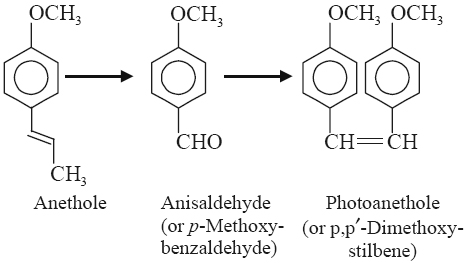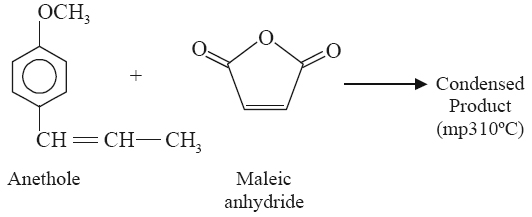CAS NO 20283-92-5
History
Rosmarinic acid was first isolated and characterized in 1958 by two Italian chemists ML Scarpatti and G. Oriente from rosemary (
Rosmarinus officinalis).
[2]
Natural occurrences
Rosmarinic acid accumulation is shown in hornworts, in the fern family
Blechnaceae and in species of several orders of mono- and dicotyledonous angiosperms.
[3]
Biosynthesis
The biosyntheses of caffeoylshikimate, chlorogenic acid and rosmarinic acid use
4-coumaroyl-CoA from the general phenylpropanoid pathway as hydroxycinnamoyl donor. The hydroxycinnamoyl acceptor substrate comes from the shikimate pathway: shikimic acid, quinic acid and hydroxyphenyllactic acid derived from l-
tyrosine.
[3] Thus, chemically, rosmarinic acid is an
ester of
caffeic acid with 3,4-dihydroxyphenyl lactic acid, but biologically, it is formed from 4-coumaroyl-4'-hydroxyphenyllactate.
[8] Rosmarinate synthase is an enzyme that uses
caffeoyl-CoA and 3-(3,4-dihydroxyphenyl)lactate to produce CoA and rosmarinate.
Hydroxyphenylpyruvate reductase is also an enzyme involved in this biosynthesis.
[9]
The enzymes involved in the biosynthesis pathway probably evolved from those used in the formation of chlorogenic and caffeoylshikimic acids.
[3]
In plants, rosmarinic acid is supposed to act as a preformed constitutively accumulated defense compound.
[10]
Clinical importance
Unconjugated rosmarinic acid and its metabolites remain in the bloodstream of rats for enough time to reach the brain and decrease
acetylcholinesterase activity.
[15] Rosmarinic acid may be transported in the bloodstream bound to human
serum albumin and
lysozyme.
[16]
Rosmarinic Acid

Rosmarinic acid (alpha-o-caffeoyl-3,4-dihydroxyphenyl lactic acid) (“RA”) (Formula 3) is a naturally occurring hydroxylated compound and analogue of caffeic acid (3,4-dihydroxycinnamic acid). Caffeic acid and its derivatives, such as rosmarinic acid, carnosol, and carnosic acid—all of which manifest antioxidant activity—are thought to be the key constituents of rosemary. Notably, rosmarinic acid is a common component of some fern and hornwort species, as well as species of the Boraginaceae family and, particularly, the Lamiaceae family. The Lamiaceae family includes common culinary herbs such as basil, lavender, lemon balm, marjoram, oregano, peppermint, perilla, sage, savory, thyme, and rosemary. Rosmarinic acid is well absorbed through the gastrointestinal tract and the skin, and has been shown to augment prostaglandin E2 production and reduce leukotriene B4 production in human polymorphonuclear leukocytes. Rosmarinic acid is versatile, and used in food preservatives, cosmetics, and medical applications because of rosmarinic acid's antimicrobial, antiviral, antioxidant, anti-inflammatory, and immunomodulatory properties. Rosmarinic acid was identified as a nonsteroidal anti-inflammatory agent. Oral supplementation with the polyphenol was an effective treatment for seasonal allergic rhinoconjunctivitis, due to inhibition of the inflammatory response and the scavenging of reactive oxygen species exhibited by the compound. Antitumorigenic effects of a rosmarinic acid are due to free radical scavenging, and inflammatory response suppression. Rosmarinus officinalis extracts shows antimicrobial activity linked to their phenolic composition, (carnosic acid and rosmarinic acid). Rosmarinic acid shows also photoprotective effects against alterations induced by UVA exposure in a human keratinocyte cell lines. The application of a 0.3% rosmarinic acid emulsion on mild atopic dermatitis improves some symptoms of the disease including the erythema, transepidermal water loss, xerosis and pruritus.
Although rosmarinic acid per se may be used for the presently disclosed embodiments, a person of ordinary skill in the art will appreciate that derivatives of rosmarinic acid, e.g., esters, salts and other dermatologically effective derivatives of rosmarinic acid, may also exhibit similar functionality when used as concentrated solutions in lieu of rosmarinic acid, and such functional equivalents of rosmarinic acid are intended to be within the spirit and scope of the presently disclosed embodiments.
Other dermatological acids which may be used in the Ferulac peels of the presently disclosed embodiments include, but are not limited to, glycolic acid, mandelic acid, other AHAS, salicylic acid, trichloroacetic acid, derivatives thereof, and other equivalent dermatological acids having similar properties.
Exfoliation can be beneficial for beautifying and rejuvenating the skin. Frequent exfoliation can help rid the skin of dead tissues, oil, dirt, as well as makeup residues. Exfoliating the skin helps provide glowing skin, and can also minimize or prevent wrinkles and fine lines. Exfoliating agents are believed to act by removing clogged residues from skin pores, and may even prevent acne
References[edit]
- Jump up^ MSDS for rosmarinic acid
- Jump up^ Isolamento costituzione e dell 'acido rosmarinico (dal rosmarinus off ). ML Scarpati, G. Oriente , Ric. Sci, 1958, volume 28, pages 2329-2333
- ^ Jump up to:a b c d Evolution of rosmarinic acid biosynthesis. Petersen M, Abdullah Y, Benner J, Eberle D, Gehlen K, Hücherig S, Janiak V, Kim KH, Sander M, Weitzel C and Wolters S, Phytochemistry, Oct-Nov 2009, volume 70, issues 15-16, pages 1663-1679, doi:10.1016/j.phytochem.2009.05.010
- Jump up^ Distribution and taxonomic implications of some phenolics in the family Lamiaceae determindes by ESR spectroscopy. J. A. Pedersen, Biochemical Systematics and Ecology, 2000, volume 28, pages 229–253
- Jump up^ Clifford, M.N. Chlorogenic acids and other cinnamates. Nature, occurrence and dietary burden. J. Sci. Food. Agric. (79) 362-372, 1999
- Jump up^ Occurrence of rosmarinic acid, chlorogenic acid and rutin in Marantaceae species. Yana Abdullah, Bernd Schneider and Maike Petersen, Phytochemistry Letters, 12 December 2008, Volume 1, Issue 4, Pages 199–203, doi:10.1016/j.phytol.2008.09.010
- Jump up^ Production of rosmarinic acid and a new rosmarinic acid 3′- O -β-D -glucoside in suspension cultures of the hornwort Anthoceros agrestis Paton. Katharina Vogelsang, Bernd Schneider and Maike Petersen, Planta, Volume 223, Number 2, 369-373, doi:10.1007/s00425-005-0089-8
- Jump up^ Rosmarinic acid biosynthesis pathway at bioxyx.org
- Jump up^ Two new enzymes of rosmarinic acid biosynthesis from cell cultures of Coleus blumei: hydroxyphenylpyruvate reductase and rosmarinic acid synthase. Petersen M and Alfermann AW, Z. Naturforsch. C: Biosci., 1988, volume 43, pages 501–504
- Jump up^ Petersen M, Simmonds MSJ (2003) Rosmarinic acid. Phytochemistry 61: 121-125
- Jump up^ Bioassay-guided fractionation of lemon balm (Melissa officinalis L.) using an in vitro measure of GABA transaminase activity. Awad R, Muhammad A, Durst T, Trudeau VL and Arnason JT, Phytother Res., August 2009, volume 23, issue 8, pages 1075-1081, doi:10.1002/ptr.2712
- Jump up^ Lee HJ, Jeong YI, Lee TH, et al. (May 2007). "Rosmarinic acid inhibits indoleamine 2,3-dioxygenase expression in murine dendritic cells". Biochem. Pharmacol. 73 (9): 1412–21.doi:10.1016/j.bcp.2006.12.018. PMID 17229401.
- Jump up^ Protective effect of Heliotropium foertherianum (Boraginaceae) folk remedy and its active compound, rosmarinic acid, against a Pacific ciguatoxin. Rossi F, Jullian V, Pawlowiez R, Kumar-Roiné S, Haddad M, Darius HT, Gaertner-Mazouni N, Chinain M and Laurent D, J Ethnopharmacol., 30 August 2012, volume 143, issue 1, pages 33-40, doi:10.1016/j.jep.2012.05.045
- Jump up^ Swarup V, Ghosh J, Ghosh S, Saxena A, Basu A (September 2007). "Antiviral and anti-inflammatory effects of rosmarinic acid in an experimental murine model of Japanese encephalitis".Antimicrob. Agents Chemother. 51 (9): 3367–70. doi:10.1128/AAC.00041-07. PMC 2043228. PMID 17576830.
- Jump up^ Pedro L. V. Falé, Paulo J. Amorim Madeira, M. Helena Florêncio, Lia Ascensão and Maria Luísa M. Serralheiro. Function of Plectranthus barbatus herbal tea as neuronal acetylcholinesterase inhibitor. Food Funct., 2011, 2, 130-136.
- Jump up^ Pedro L.V. Falé, Lia Ascensão, Maria L.M. Serralheiro, Parvez I. Haris. Interaction between Plectranthus barbatus herbal tea components and human serum albumin and lysozyme: Binding and activity studies. Spectroscopy, 2011, 26, 79-92.

ROSMARINIC ACID
- 1H NMR
...

.
.
2........................... 13CNMR


.
HPLC

 2D [1H,1H]-TOCSY
2D [1H,1H]-TOCSY

.
1D DEPT90
 1D DEPT135
1D DEPT135
 2D [1H,13C]-HSQC
2D [1H,13C]-HSQC
 .
.
.
2D [1H,13C]-HMBC
 .
.
2D [1H,1H]-COSY
.

..............
http://www.scielo.br/scielo.php?pid=S1517-83822013005000061&script=sci_arttext&tlng=pt
Collection of crude extracts, fractions, and the pure compound rosmarinic acid
The aerial parts of the plant species R. officinalis were collected (3.5 kg) in the urban area of Patrocínio, located in the western region of the Brazilian state of Minas Gerais in May 2007. The geographical position of the town is latitude 18º17'00" S, longitude: 46º59'36" W; average height of 972 meters.
The aerial parts of the plant species P. crispum were collected (4 kg) from a traditional garden, located in the city of Guaxupé, located in southern region of the Brazilian state of Minas Gerais in October 2007. The geographical position of the town is latitude 21º18'20" S, longitude 46º42'41" W; average elevation of 830 meters.
Both plants were identified by Prof. Dr. Milton Groppo, Faculdade de Filosofia, Ciências e Letras de Ribeirão Preto, University of São Paulo (FFCLRP-USP), and a voucher specimen was deposited in the herbarium of the Institution, labeled as SPRF 11911th plant species P. crispum and SPRF 11912th plant species R. officinalis.
The plants were dried and stabilized in circulating air oven at a temperature of about 40 ºC, followed by grinding to a powder in a knife mill (Marconi, Piracicaba, São Paulo, Brazil). The powder resulting from each plant was subjected to exhaustive extraction by maceration with ethanol (Merck KgaA, Darmstadt, Germany)/water (96:4 v/v) at room temperature. A hydro solvent was employed, in order to obtain more polar substance(s). Three successive extractions were accomplished, with one-week interval between them. All the material resulting from the maceration process was filtered and concentrated under reduced pressure at 60 ºC until complete elimination of the solvent, using a rotary evaporator (Marconi, Piracicaba, São Paulo, Brazil).
The dried plant extracts were placed in an amber bottle covered with a lid and were stored in the refrigerator until the tests were conducted. Fractionation of the extract of R. officinalis (12.0 g) was performed by vacuum liquid chromatography (VCL-silica gel 60, Merck) using n-hexane, ethyl acetate, ethanol (all purchased from Merck), or mixtures of these solvents in increasing polarity gradient as eluent, which furnished seven fractions. A volume of two liters of solvent or solvent mixtures was necessary for the collection of each fraction. Fractions 1, 2, 3, 4, 5, 6, and 7 were eluted with n-hexane, hexane/ethyl acetate (75:25 v/v), hexane/ethyl acetate (50:50 v/v), ethyl acetate, ethyl acetate/ ethanol (75:25 v/v), ethyl acetate/ ethanol (50:50 v/v), and ethanol, respectively, which yielded masses of 0.4, 2.4, 4.4, 1.8, 0.6, 0.7, and 0.5 g, respectively.
A yellowish solid substance, namely rosmarinic acid (designated RA), was isolated from the extraction. To this end, 200 g powdered leaves of the plant that had been submitted to extraction by maceration (room temperature) for seven days using water/acetic acid (85:15 v/v) were employed. The product of maceration was filtered, and the pH was adjusted to 10 by addition of a calcium hydroxide (Merck) solution. This gave a precipitate (27 g) that was identified by comparison with an authentic RA sample. The final identification was carried out by 1H and 13C NMR. The data were compared to those published for rosmarinic acid (Kuhnt et al., 1995), which confirmed that RA was actually rosmarinic acid.






